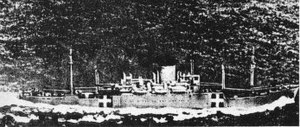MV Awa Maru (1943)

Awa Maru
|
|
| History | |
|---|---|
|
|
|
| Name: | Awa Maru |
| Operator: |
|
| Builder: | Mitsubishi Shipbuilding & Engineering Co. Nagasaki, Japan |
| Yard number: | 770 |
| Laid down: | 10 July 1941 |
| Launched: | 24 August 1942 |
| Completed: | 5 March 1943 |
| In service: | 1943 |
| Out of service: | 1 April 1945 |
| Fate: | Torpedoed and sunk by USS Queenfish |
| General characteristics | |
| Tonnage: | 11,249 gross register tons (GRT) |
| Length: | 153 m (502 ft) |
| Beam: | 20 m (66 ft) |
| Propulsion: | 2 diesels, twin screws |
| Speed: | 17 knots (31 km/h) |
| Notes: | Steel construction |
The Awa Maru (阿波丸?) was a Japanese ocean liner owned by Nippon Yusen Kaisha. The ship was built in 1941–1943 by Mitsubishi Shipbuilding & Engineering Co. at Nagasaki, Japan. The vessel was designed for passenger service, but the onset of war by the time work was completed changed requirements, and she was requisitioned by the Japanese Navy. While sailing as a hospital ship under the protection of the Red Cross in 1945, she was torpedoed by USS Queenfish (SS-393), killing all but one of 2,004 people aboard.
The ship's name came in part from the ancient province of Awa on the island of eastern Shikoku in the modern prefecture of Tokushima. This mid-century Awa Maru was the second NYK vessel to bear this name. A 6,309-ton Awa Maru was completed in 1899 and taken out of service in 1930.
The ship was built by Mitsubishi at Nagasaki on the southern island of Kyushu. The keel was laid down in the summer of 1941 (July 10, 1941). The Awa Maru was launched on August 24, 1942; and she was completed on March 5, 1943.
The Awa Maru was requisitioned and refitted for auxiliary use by the Imperial Japanese Navy during World War II. On 26 March 1943, Awa Maru left Japan carrying 3,000 tons of ammunition for Singapore. Awa Maru traveled to Singapore with convoy Hi-3 in July 1943, and returned to Japan with convoy Hi-14 in November. She again traveled to Singapore with convoy Hi-41 in February 1944, and returned to Japan with convoy Hi-48 in March. She then transported troops to Burma with convoy Hi-63 in May, and returned to Japan with convoy Hi-66 in June.
...
Wikipedia
